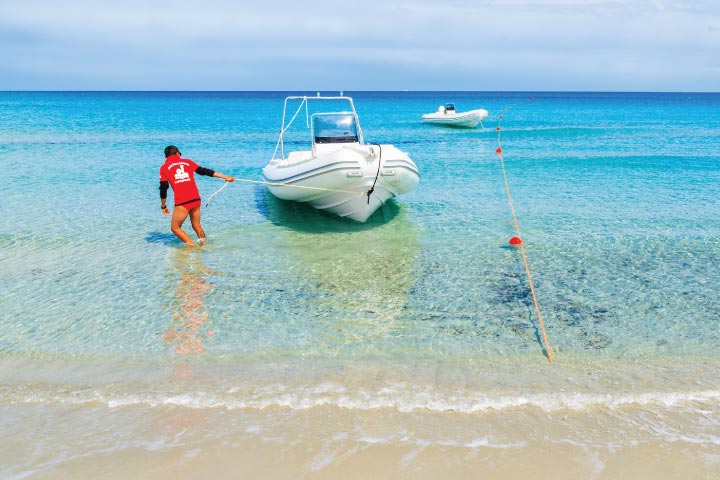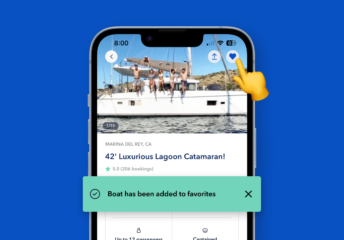Beaching a Boat: How to Anchor on a Sandbar
Last Updated on November 3, 2023 by Boatsetter Team
Knowing how to anchor a boat at the beach will come in handy when the desire strikes to laze near the shore of a deserted beach or join a sandbar party.
Also sometimes called “beaching a boat,” pulling the bow up to the sandbar or beach may be necessary for keeping the good vibes flowing. This post will walk you through a surprisingly simple process.
Rent. Charter. Share— Only at Boatsetter
How to Beach a Boat
Follow these steps for beaching your boat to anchor on a sandbar:
- Check your beach’s environment for rocks or other solid objects that could damage the boat.
- Tilt your boat’s outdrive up to minimize draft while leaving the propeller fully submerged.
- Point directly at the beach or sandbar and idle towards it at minimum speed.
- Watch your depth finder (if you don’t have one, use a boathook or paddle to test the depth). If it becomes so shallow the propeller or drive unit might hit bottom, shut the engine off. At that point, it should be shallow enough for someone to enter the water and walk the boat into the beach.
- Depending on the size of the boat, a crew member or two can lift and pull on the bow to bring it up onto the sand.
- With the boat now beached, anchor it in place.
Never beach a boat and expect it to stay there— wind, waves, and shifting tides can drift the boat away from shore. To prevent the boat from floating away, you should anchor your boat on the beach.

Steps on Anchoring Down at a Beach
- Lower the anchor to the beach, or hand it down to a crewmember.
- Walk it at least 20 to 30 feet away from the water.
- Manually dig the anchor fluke into the sand, or bury the anchor, to ensure it’s secure.
- Get back on the boat, and pull the anchor line tight. Then, secure it to a bow cleat.
With your boat now beached and anchored, it’s time to kick back and relax. You should, however, always keep an eye on a beached boat. An incoming tide or large waves can re-float a beached boat, which can turn sideways onto the beach.
In this case, you’ll want to pull the bow back up and re-tighten the anchor line. If the seas grow rough or a crowd of boats is going by you may want to move the boat off the beach and set out a stern anchor to prevent it from pounding on the sand.
If there’s an outgoing tide, be sure to move the boat back as the water recedes or you might find it impossible to re-float the boat when it’s time to go home.
Beaching a boat is the gateway to an incredible beach day. Follow our guide for beaching your boat and anchoring a boat at the beach, and have fun!

FAQs
Does beaching a boat damage it?
The vast majority of the time, no, no damage will occur. But whenever your boat comes into contact with something solid the possibility for damage exists. In the case of beaching, damage usually results from hitting a rock, thick shells, or some hard object other than the sand itself. Boats with painted bottoms may also be subject to some paint wearing off where it rubs the sand.
Can you beach a fiberglass boat?
Absolutely! Countless people beach their fiberglass boats each and every day of the year.
Can you beach an inboard boat?
If the sandbar or beach you’re approaching has a very sharp drop-off close to shore it may be possible. But generally speaking, inboard boats have a draft that’s too deep for beaching. Most of the time they’ll run aground before reaching the beach.
How do you protect a boat hull when beaching a boat?
Keel guards, usually made of flexible plastic or vinyl, can be put on a boat that’s beached regularly. In areas where there are rocks or hard shells commonly found on the beaches, these can be quite popular.
About Boatsetter
Boatsetter is a unique boat-sharing platform that gives everyone — whether you own a boat or you’re just renting — the chance to experience life on the water. You can list a boat, book a boat, or make money as a captain.
List. Rent. Earn— Only at Boatsetter

With over three decades of experience in marine journalism, Lenny Rudow has contributed to dozens of boating and fishing publications and websites ranging from BoatU.S. Magazine to BDOutdoors.com. Rudow is currently the Angler in Chief at Rudow’s FishTalk, he is a past president of Boating Writers International (BWI), a graduate of the Westlawn School of Yacht Design, and has won numerous BWI and OWAA writing awards.










